|

University
Welcomes CNN's On The Story | GW
Board Elects New Trustees | National
Security Declassified | Rooney
Addresses Class of 2005 | Brady
Gallery Exhibitions | NIH
Grant to Help Vocal Surgery Patients |
Responding to the Call
of Katrina | University
Welcomes New Deans | Harnessing
Success | Swartz
Named Vice President | ‘Kuwait
Chair’ Endowed | Hi
Yo Silver, Away! | A
Faculty for Writing

University Welcomes CNN’s On the Story
GW began a new chapter in its ongoing relationship
with CNN on July 8, when the Jack Morton Auditorium
opened its doors to On the
Story, an interactive,
global news program that tapes every Friday evening
on campus in GW’s Media and Public Affairs
Building before a studio audience.

|

CNN’s
Kyra Phillips takes a question from
a GW student as senior Pentagon correspondent
Barbara Starr, Congressional correspondent
Joe Johns, and Homeland Security correspondent
Jeanne Meserve look on.
Julie Woodford
|
The one-hour show, featuring CNN chief international
correspondent Christiane Amanpour as part of
a rotating cast of CNN reporters, transports
viewers behind the headlines of the world’s
top weekly news stories. An insider’s look
at what it’s like for CNN journalists to
be on the front lines of the hottest news events
around the globe, the program features first-hand
accounts of the newsgathering process, never-before-seen
raw news footage, and questions from the studio
audience.
“GW is pleased and proud to continue our
partnership with CNN, especially on a program
that brings together top correspondents from
around the world to offer the audience additional
depth and perspective on the top stories of the
week,” says GW Vice President for Communications
Michael Freedman. “GW students have a unique
opportunity to go behind the scenes, ask questions
of the correspondents, and learn more about the
process of gathering, sorting, and reporting.
Judging from the tremendous interest even during
the heat of summer, I’d say CNN On
the Story will be a hot ticket on campus and across
Washington throughout the year.”
Lucy Spiegel, senior executive producer of
On the Story and CNN vice president for weekend
programming, says that CNN is glad to make GW
the show’s new home. “Taping On
the Story at GW is a terrific opportunity to do a
hard news show in front of a live audience in
a top-notch facility,” she states. “Our
relationship with GW is an important factor in
the success of our show.”
At GW, On the Story replaces CNN’s leading
political debate program Crossfire, which ended
production on June 3 after airing 736 shows live
from the Jack Morton Auditorium in the Media
and Public Affairs Building. The program drew
much excitement during its three years at GW,
where some 117,000 visitors participated as studio
audience members and more than 200 students served
as Crossfire interns, volunteers, and staff.
“We are thrilled to host a new CNN program
at GW,” says Heather Clapp Date, coordinating
producer of CNN at GW. “We have enjoyed
terrific audience involvement and turnout for
the first few weeks of On
the Story at GW, helping
us get off to a great start.”
On the Story is taped from 7:30 to 8:30 p.m.
every Friday. Doors open at 6:30 and audience
members must be seated by 7:10. The program airs
on CNN Saturdays at 7 p.m. and replays Sundays
at 10 a.m. To reserve free tickets for the studio
audience, please call 202-994-8CNN or visit CNN.com/OntheStory.
—Jamie L. Freedman
GW Board Elects New Trustees
In August, the GW Board of Trustees elected
four new trustees and two new emeritus
trustees.
Serving as new charter trustees are:
Gary C. Granoff, BBA ’69, JD ’73,
chairman and president of Ameritrans
Capital Corp., who has previously served
on GW’s Board of Trustees; and
Delano Lewis, Hon. DPS ’91, former
U.S. ambassador to South Africa and
former president and chief executive
officer of National Public Radio.
The newly elected alumni trustees are:
Gerald Lazarus, MD ’63, director
of the Wound Healing Center and chief
of dermatology at the Johns Hopkins Bayview
Medical Center; and Jeanette Michael,
JD ’75, executive director of the
D.C. Lottery and Charitable Games Control
Board.
Newly elected emeritus trustees are:
Joseph L. Brand, JD ’63, a partner
at Patton Boggs, LLP; and Morton I. Funger,
BA ’53, a partner with Ralmor Corp. |
National Security Declassified
Before 9/11, the most-viewed photograph on the
National Security Archive’s Web site was
the Oval Office meeting of Elvis Presley and
Richard Nixon. Since the attacks, it has been
a photograph of Secretary of Defense Donald Rumsfeld
shaking hands with Saddam Hussein. As subjects
such as terrorism and the Patriot Act gain public
attention, the archive’s services are increasingly
in demand.
Housed in GW’s Gelman Library since 1994,
the archive serves many roles: research institute
on international affairs; library and archive
of declassified U.S. documents obtained through
the Freedom of Information Act; public interest
law firm; and publisher of documents in book,
microfiche, and electronic formats. It was created
in 1985 and formerly was housed at the Brookings
Institution. Today, it has nearly 30 staff members,
analysts, and fellows. Funding comes from publication
revenues and from private philanthropists—the
archive receives no government funding.
“We act as a clearinghouse to help people
use FOIA, use the documents obtained through
FOIA, and sometimes unite people who are all
looking into the same things, whether they’re
journalists or educators,” says Malcolm
Byrne, deputy director and director of research.
The need for the archive was made clear to
Washington Post reporter Scott Armstrong in the
early 1980s when he requested a government document
and was provided with a memo with the top half
blacked out. Raymond Bonner of The
New York Times received the same memo—with the bottom half blacked
out. They put the missing pieces together and
realized the disorganization and the arbitrary
nature of access to classified documents.
With the archive’s help, the public puts
together other such missing pieces on many subjects,
namely government involvement overseas and matters
of national security. GW was tapped to house
the archive, Byrne says, because of the strength
of the Elliott School of International Affairs
and the history department, the enthusiasm of
Gelman’s staff, and support from GW’s
administration.
The archive has made more than
30,000 FOIA requests. Supporting more than 30
terminals, its computer system hosts databases
of released documents—more
than 100,000 records—and FOIA requests
filed by the staff and outside requestors on
international affairs—more than 20,000
records.
Staff members field more than 2,500 public
service requests every year, testify before Congress,
lecture at universities, host topical conferences,
and make media appearances to discuss FOIA and
the various topics for which the archive’s
collections provide documentation. The archive’s
publications have won critical acclaim and honors
including the George Polk Award for Journalism.
Recently, the archive won a 2005 Emmy Award for
achievement in news and documentary research
for Declassified: Nixon
in China, originally
broadcast on the Discovery Times channel.
Perhaps its most significant contribution is
changing the way the public views its right to
information and the government’s response
to information requests.
“Today, it seems natural that the government
shouldn’t do something like erase the e-mail
tapes from the Reagan administration. We can’t
just ‘hit erase’ on those sorts of
matters,” Byrne says. “But as technology
and laws and world events change, public entities
have to stay on top of monitoring such activity.”
—Laura Ewald

Rooney Addresses Class of 2005
Washington’s Ellipse sparkled under sunny
skies May 22, as more than 23,000 GW graduates,
family members, and friends celebrated Commencement
2005.
Three-time Emmy Award-winning CBS News commentator
Andy Rooney delivered the keynote address and
received an honorary Doctor of Public Service
degree. In a special commencement highlight,
Rooney’s granddaughter Alexis Rooney Perkins,
BA ’05, who received her Bachelor of Arts
degree in history at the ceremony, presented
her grandfather with his honorary degree.
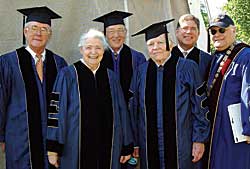
GW Board of Trustees Chairman Charles
T. Manatt (far left) and President Stephen
Joel Trachtenberg flank honorary degree
recipients (from left) Mildred S. Dresselhaus,
Philip K. Russell, Andy Rooney, and
Alberto Ibargüen.
Julie
Woodford
|

|
Inspirational words of wisdom also flowed from
GW’s other honorary degree recipients:
renowned physicist Mildred S. Dresselhaus, who
was awarded an honorary Doctor of Science degree;
acclaimed newspaper executive Alberto Ibargüen,
former publisher of The
Miami Herald and of El
Nuevo Herald, who received an honorary Doctor
of Letters degree; and retired Maj. Gen., Philip
K. Russell, a top medical researcher, who was
honored with a Doctor of Public Service degree.
Outstanding members of the GW community were
recognized during the ceremony for their contributions
to the University. Four faculty members won
Oscar and Shoshana Trachtenberg Prizes for excellence:
Marie Price, associate professor of geography,
received the prize in teaching; Amitai Etzioni,
University Professor, and Jozef Przytycki,
professor of mathematics, received the prize
in research scholarship; and Arthur E. Wilmarth,
professor of law, received the prize in university
service.
The Distinguished Alumni Achievement Award
went to: Robert Ames Alden, BA ’65, MA ’68,
the longest serving Washington
Post editor in
the newspaper’s history; Walter M. Bortz
III, EdD ’98, president of Hampden-Sydney
College in Virginia and a former vice president
at GW; Diana B. Henriques, BA ’69,
a New York Times reporter specializing
in white-collar crime and corporate governance
issues; James F. Humphreys, JD ’78, long-time West Virginia
legislator; Pradman Kaul, BS ’67, CEO and
chair of Hughes Network Systems; Floyd D. Loop,
MD ’62, CEO and chair of the board of governors
of The Cleveland Clinic Foundation from 1989
to 2004; Christine E. Seidman, MD ’78,
Harvard Medical School professor and director
of the Cardiovascular Genetics Service at the
Brigham and Women’s Hospital; and George
W. Wellde Jr., MBA ’76, a managing director
at Goldman Sachs & Co.
The second annual Manatt-Trachtenberg Prize
recognizing undergraduate leadership was presented
to Lina Musayev, who also received her degree
in political communication at the ceremony. Musayev
is the co-founder and executive director of United
Students for Fair Trade, a national nonprofit
organization that advocates for progressive and
humanitarian economic policies aimed at improving
the lives of impoverished farmers and laborers
in developing countries.
—JLF

Brady Gallery Exhibitions
The Luther W. Brady Art Gallery is offering
two exhibitions this fall. The gallery is open
Tuesday through Friday, 10 a.m. to 5 p.m.,
unless otherwise stated. For more information,
visit www.gwu.edu/~bradyart.
John Walker: Works on Paper 1990-2004
Organized by the Portland Museum of
Art, Maine.
Sept. 6 through Oct. 28
Imagination and Knowledge:
Centennial Celebration of Einstein’s
Miraculous Year
Featuring photographs of Albert Einstein from
GW President and Mrs. Stephen Joel Trachtenberg’s
collection; and furniture on loan from the Historical
Society of Princeton—including never-before-displayed
pieces of Einstein’s personal furniture.
The exhibition is being sponsored by the Office
of the Executive Vice President for Academic
Affairs and other GW resources.
Nov. 2 through December.

NIH Grant to Help Vocal Surgery Patients

|
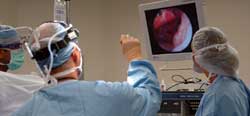
GW Professor
of Surgery Dr. Steven Bielamowicz (center),
during a recent medialization laryngoplasty,
a procedure used to correct vocal fold
problems.
|
A four-year, $2.8 million grant from the National
Institutes of Health is helping GW researchers
develop computer-based tools to improve the success
rate of surgeries performed to alleviate voice
disorders caused by vocal chord weakness. The
project pairs the School of Medicine and Health
Sciences and the School of Engineering and Applied
Science.
Vocal fold problems can impair voice production,
impeding the ability to work and conduct social
interactions. The shortcoming of the current
surgical procedure used to correct the problem
and restore the patient’s voice, medialization
laryngoplasty, is that it is dependent on the
surgeon’s skill and intuition: The procedure
fails in about 24 percent of cases, and additional
surgery is required.
Development of an image-guided procedure began
in September. “By superimposing the CT
data from the patient with the actual larynx
of the patient during surgery, we are essentially
giving the surgeon X-ray vision,” says
James Hahn, chair of the Department of Computer
Science and of the Institute for Biomedical Engineering.
Hahn says this will allow the surgeon to place
an implant with much more accuracy than is currently
possible.
Steven Bielamowicz, GW professor of surgery,
is principal investigator of the project.

Responding to the
Call of Katrina
In the weeks following Hurricane Katrina, members
of The George Washington University community
donated time, food, supplies, and money to
help residents pick up the pieces of their lives.
Meanwhile, the University opened its doors,
sheltering students and administrators from the
storm-ravaged region and enabling them to restart
their academic lives.
A medical team of 19 health care professionals
led by GW professors Christina Catlett, assistant
professor of emergency medicine, and Yolanda
Haywood, assistant dean for student and curricular
affairs and associate professor of emergency
medicine, traveled Sept. 12 to Baton Rouge, La.,
to help victims of Katrina. The team assisted
with medical needs by screening patients in the
region’s shelters.
More than 175 members of the University community
attended a Disaster Relief Volunteer Training
seminar run by the American Red Cross in Ross
Hall, Sept. 9. The seminar, compressed into
a three-hour session with an additional three-hour
online course, qualified volunteers to receive
full disaster relief certification.
In further support of the Red Cross’s activities,
immediately following the disaster, the University
initiated a hurricane relief effort under the
jurisdiction of the Medical Center in coordination
with the Red Cross. Just a week into the drive,
John F. “Skip” Williams, University
provost and vice president for health affairs,
reported the drive raised more than $21,000 in
hurricane relief donations. The Medical Center
continues to accept donations. For more information,
please call 202-994-3727.
The University also opened its doors to students,
allowing students from affected schools to
enroll at GW with nondegree status on a space-available
basis. As many as 75 students are now enrolled
at various levels within the University organization.
GW also has offered residential and office
space to administrators of flood-ravaged Dillard
University, and is now providing those services
to one of the vice presidents of Dillard.
—Thomas Kohout

University Welcomes New Deans
This fall, two new deans joined the GW administration:
Michael E. Brown as dean of the Elliott School
of International Affairs and Frederick M.
Lawrence as dean of the Law School.
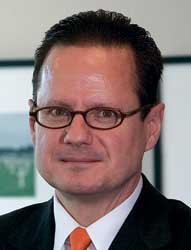
Michael E. Brown
|

|
Formerly director of the Center for Peace and
Security Studies at Georgetown University,
Brown is an international security expert. His
education career also includes serving as senior
fellow and associate director of the international
security program at the Belfer Center for Science
and International Affairs at Harvard from 1994
to 1998.
He is co-editor of International Security,
a prominent security studies and international
affairs publication, a post he has held for
12 years. Brown was selected after an extensive
global search. In addition to editing and co-editing
18 books, he wrote Flying
Blind: The Politics of the U.S. Strategic Bomber
Program, which won
the Edgar Furniss Book Award. He also serves
as professor of international affairs and of
political science.
Harry Harding, former ESIA dean, now serves
as a University Professor.
|
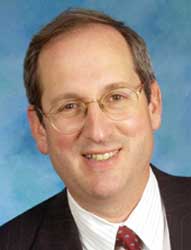
Frederick M. Lawrence |
Frederick M. Lawrence was appointed dean of
the Law School after a yearlong search during
which Roger Trangsrud served as interim dean.
Chosen from more than 175 applicants, Lawrence
comes to GW from Boston University School of
Law and also serves as Robert Kramer Research
Professor of Law.
Lawrence is a leading expert in civil rights
and has written five books, including Punishing
Hate: Bias Crimes Under American Law.
Having served as a delegate to the meeting
of the Organization for Security and Cooperation
in Europe on Enactment and Enforcement of Legislation
to Combat Hate-Motivated Crimes, Lawrence has
lectured internationally on the subjects of
bias crime law and civil rights, and since
2003 also has served as chair of the National
Legal Affairs Committee of the Anti-Defamation
League.
Harnessing
Success
A little “puttering” can
yield huge results. Just ask GW Professor
of Engineering Roger E. Kaufman, a mechanical
engineer with a passion for designing
gadgets. Throughout his career, Kaufman
has earned acclaim for inventing novel
instruments such as virtual reality surgical
simulator devices for training doctors,
as well as numerous aids for the handicapped.
Kaufman is now putting his expertise
to work for the U.S. military with his
latest invention, the Close-Quarter Combat
Training Simulator Harness.
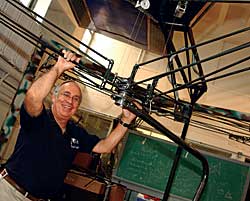
GW Professor of Engineering
Roger E. Kaufman is helping to
revolutionize the way that U.S.
Marines train for battle through
his latest invention—the
Close-Quarter Combat Training Simulator
Harness.
|

|
Designed and built in the GW School
of Engineering and Applied Science machine
shop for the Naval Research Laboratory,
Kaufman’s series of virtual reality
harnesses are part of the Navy’s
Virtual Technologies and Environment
program. The unique mechanisms—invented
to enhance virtual reality training in
confined spaces—may eventually
revolutionize the way Marines train for
battle. “My harness allows Marines
to move freely within view of the tracking
camera system while wearing head-mounted
virtual reality goggles,” Kaufman
explains. “The harness keeps Marines
centered in the camera’s field
of vision, while allowing them to spin,
turn, jog in place, get down on the ground
and roll, move around on their knees,
or fire from a prone position.” Prior
to Kaufman’s invention, Marines
using the technology were forced to stand
in one spot.
Although he calls the device “one
tiny part of a huge project,” it
is generating excitement in the military
world. This is hardly the first time
that Kaufman’s work has caught
the public eye. Early in his career,
he created the much-loved FORTRAN
Coloring Book (The MIT Press, 1978), a technical
computer book handwritten and drawn in
a lively style similar to Dr. Seuss.
The work, which he confesses he wrote
only because the textbook for a Fortran
course he was teaching at MIT did not
come in on time, received worldwide accolades
and spawned a flood of copycat books
in Germany and other countries. “It
started as an inside joke and ended up
becoming pretty famous, making The
New York Times Noteworthy Paperbacks
list,” Kaufman
says. “Ted Geisel, the real
Dr. Seuss, even sent me a nice note complimenting
the Coloring Book and saying he wished
he’d had a text like that when
he was a student at Dartmouth.”
Kaufman, who earned a PhD in 1969 from
Rensselaer Polytechnic Institution, gained
notoriety early in his career for designing
the first polycentric knee joint on the
computer that exactly replicated the
motion of a human leg. He also is credited
with developing an early computer-aided
design system for creating linkage mechanisms,
as well as one of the world’s first
interactive computer graphic systems.
His inventions for children with neuromuscular
problems—including a hand-eye coordination
trainer—were featured in the 1976
Jerry Lewis Telethon.
A GW professor since 1976, he has developed
a number of virtual reality instruments
for GW Medical School, including devices
for training surgeons performing laproscopic
and endoscopic procedures, urologists
performing cryosurgery, and medical personnel
performing needle sticks. Kaufman also
burns the midnight oil inventing devices
at home in his basement, an avocation
that indirectly led to his recent work
with the NRL. A number of years ago,
he explains, he met a brilliant GW electrical
engineering doctoral student who’d
been born without arms. “I asked
him what gadgetry might be helpful to
him and he replied that it would be great
to have a device that would help him
get dressed,” he says. “In
my basement, I designed and built two
foot-operated dressing machines to help
him put on his shirt and pants.” The
former student, who is now a senior scientist
at the Naval Research Lab involved in
the VIRTE program, remembered those machines
that Kaufman had built for him years
ago and called upon him to build the
combat training simulator harness.
Now several years into the project,
he says that he’s thoroughly enjoying
the experience. “I love inventing
gadgets and I love to putter, so I’m
having a ball.”
—JLF |
Swartz Named Vice President
Building on six years of technological leadership
as GW’s CIO, David Swartz was named vice
president responsible for Information Systems
and Services in August. He will continue CIO
duties and also will manage new areas including
student technology services and residential
networking.
 Julie Woodford
Julie Woodford
|

|
Swartz has helped to consolidate the University’s
IT infrastructure into an integrated organization
with 260 employees and a $40 million budget.
He also oversaw the replacement of GW’s
mainframe applications with powerful servers
supporting Web-based applications that simplify
access and ease of use. His efforts were recognized
in a cover story in The
Chronicle of Higher Education in July.
He also has helped raise the University’s
visibility as a technology leader. In August,
GW’s ISS department was named a recipient
of CIO magazine’s “Bold 100” award.
The honor recognizes organizations that embrace
great risks to achieve great rewards. GW was
chosen in part for its plan to improve business
continuity, disaster recovery, and user services
on all campuses by developing a second data center
on the Virginia Campus. The move was part of
the University’s preparedness response
to the Sept.11, 2001, terrorist attacks. ISS
was praised for “choosing continuity, not
disaster recovery.”

‘Kuwait Chair’ Endowed

|
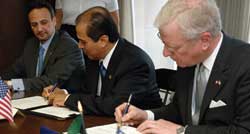
Vice President
and General Counsel Dennis Blumer signs
the agreement establishing the Kuwait
Chair for Gulf and Arabian Peninsula
Affairs with a $3.3-million gift from
the Kuwait Foundation for the Advancement
of Sciences.
Julie Woodford
|
In July, GW received more than $3.3 million
from the Kuwait Foundation for the Advancement
of Sciences to fund the Kuwait Chair for Gulf
and Arabian Peninsula Affairs in GW’s Elliott
School of International Affairs. Former U.S.
Ambassador to Kuwait Edward “Skip” Gnehm
was named the first Kuwait Chair. His focus in
the role is to give students the resources and
expertise needed to better understand the Gulf
and Arabian Peninsula.
GW enjoys close ties with the country of Kuwait.
Kuwaiti Prime Minister Sheikh Sabah Al-Ahmad
Al-Jaber Al-Sabah was honored by the University
at a convocation June 30, in which GW President
Stephen Joel Trachtenberg awarded Sabah an honorary
Doctor of Laws degree.
Sabah is among the longest-serving government
officials in the Middle East. He began his career
in 1954 and was a member of the founding commission
that drafted the constitution of the State of
Kuwait. Other major accomplishments include playing
a central role in securing the right to vote
and hold office for Kuwaiti women and playing
a central role in Kuwait’s participation
in the United Nations.
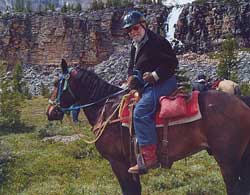
|
|
Hi
Yo Silver, Away!
Yes, even university presidents
are allowed a respite. For his, President
Stephen Joel Trachtenberg journeyed
to Banff, Alberta, Canada, for a
week of horseback riding in late
July. Here he and trusty horse Molson
make their way through the Canadian
Rockies.
|
|
|